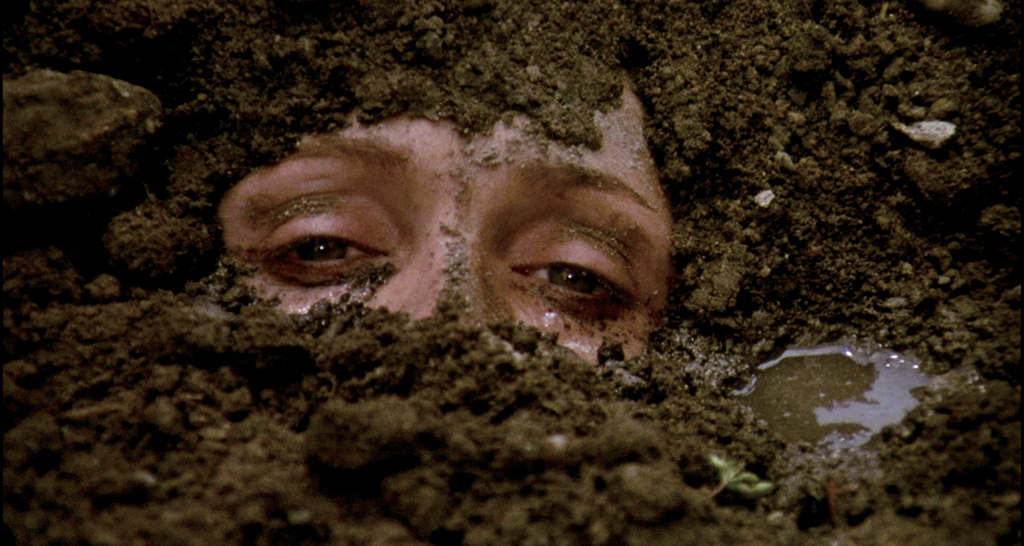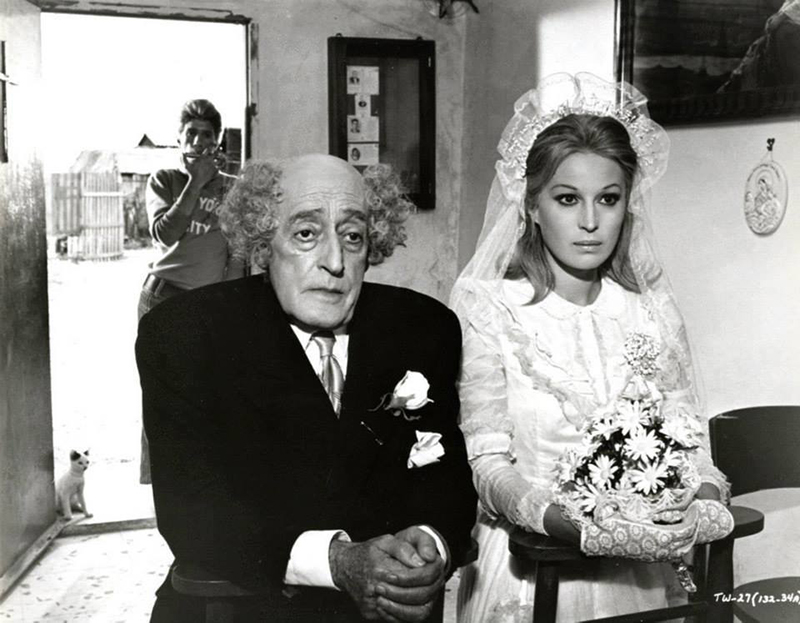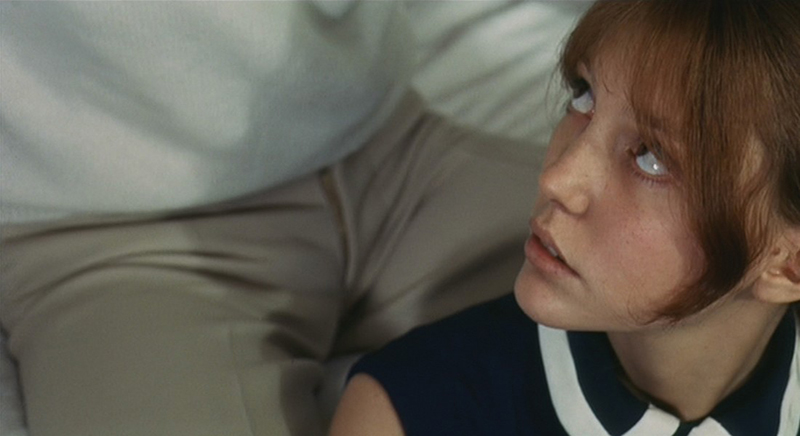Pier Paolo Pasolini Pt. 3

PIER PAOLO PASOLINI: THE BRUTALITY OF COHERENCE: PART 3
By Miguel Angel Barroso Image (above) from "Teorema" (1968)
For Pier Paolo Pasolini walking the road of Totó and Ninetto is the way of the world and involves the search for answers to such common issues as the meaning of death, the exploitation of man by man, the existence of rich and poor, the causes of the fish big eats the boy. The road (main protagonist of the film) also marks the journey of life, the sense of going through the world with all that it entails suffering, love, transcendence. Pasolini had not plateaued or gone all the way, but the world had changed and it was necessary to find other aesthetic forms. If literature was not enough to shed his expressive needs, the film had to provide new resources, new methods that find artistic findings through the lens of a camera. Hence all technical risks, which can never be controlled in a first film essay, and that will give your film several masterpieces. For Pasolini, the idea of returning to roll with Totó became a vital necessity, since, after analyzing calmly Uccellacci and Uccellini, he realized how well it worked this unusual pairing of Totó and Ninetto Davoli, and how much that they could obtain short term. Pasolini feels "free", artistically speaking, for the first time since a long time. According to his own confession, Uccellacci and uccellini meant saturation style; more or less the straw that breaks the camel and moves to reflection about its cinematographic and artistic in general future.
So he wanted his next job was light, without falling into the simple, and could show that her comedic was more than a coincidence. Pier Paolo Pasolini was so stripped of style that even drew a storyboard of his next film titled La Terra vista dalla Luna, a film thirty minutes to be inserted in a collective feature film, whose generic title was Le Streghe and had great film directors like Luchino Visconti, Mauro Bolognini and Vittorio de Sica. The terra vista dalla luna was the first film shot Pasolini, having spent a month in bed because of a bleeding caused by an ulcer. That rest was born his theater; a unique theater he called Theatre of the word. La Terra vista dalla Luna is not a masterpiece like the Ricotta , but reaches heights of stylistic perfection before which even critics of the filmmaker, will have to surrender. Totó may be here more exaggerated in their gestures, but that does not mean it is out of tune, since Pasolini rolled a surreal story that needed farce; In addition, the contrast between Toto and extraordinary actress Silvana Mangano, is pure dynamite, and if we add the dressing of a nonprofessional film actor as Ninetto Davoli: the experiment is served. The tribute to Pasolini some of his most admired film directors, Charles Chaplin, is evident, not because his photograph appears between unlikely objects that are in the house Totó, but by the inclusion of numerous scenes, both comic as poetic. Pasolini's last collaboration with Totó, occurs when returning filmmaker Morocco, where he has been looking for locations for his new film Oedipus Rex.

La Terra vista dalla Luna Pasolini had in mind a series of stories designed as comics in which he saw Toto and Davoli Ninetto as ideal for romancing couples. They were his last thoughts on the film I wanted to do. Che cosa sono le nuvole? 1968, continues the path begun with the previous short, and long distance Uccellacci and uccellini. The principal has the feeling that has not taken enough out of your two actors, and feel the need to engage them in body and soul. Che cosa sono le nuvole? Goes further in his attempt to make a cool movie, with no apparent intention, though fraught with serious proposals about life and the human condition. The film is locked again in a film skits, history Pasolini being the brightest of all. The film was shot in a week and had absolute freedom by the film producer Dino de Laurentiis. It is also his only film shot with live sound and mount accepts without further dubbing. The reasons were obviously lack of time, as his concept of sound was not realistic, but creative and that only permitted the dubbing room. A few months later, rolling Oedipus re in Morocco, Pier Paolo Pasolini receives the news of the death of Totó.
A blow came down all illusions that the film director had put in his new film, next to the father he never had. As a result, the film Pasolini became again; he changed his style and aesthetic direction. He had lost the illusions of directing movies with comic dyes and framed within the story. With Oedipus Rex, 1967, Pasolini tackles his most risky project, because the film breaks dramatically with all his film and initiates a new phase in his career, taken unanimously by all the criticism, as the most complex and intellectualized. But it is not an intellectual pose this his new aesthetics, but the urgent need to continue living as an author with expressive needs, that has something to say of himself to others. The film is not an autobiography of the movie director, as many have wanted to see, although it has many common points with his life. It was the right time to take out demons of the past (the father figure) and face-to-face with life time. The film is an adaptation of the play by Sophocles, though Pasolini creates a prologue and an epilogue that takes place in the present. This puzzled the public and much criticism, but certainly this is one of the great successes of the film.
Oedipus Rex is the most dispassionate of his films, precisely because the film director is not involved emotionally, but intellectually and its claim, besides the artistic, is overcoming a problem. His father, Carlo Alberto, neck accepted her son's homosexuality, nor could bear the lack of love of his wife Susanna, and that devote all his attentions to his eldest son Pier Paolo. Pasolini was a victim of that marital hatred, forcing him to take sides with one of the two. And he chose his mother. Oedipus Rex also initiates its "stage of barbarism", advocated by Pasolini in many interviews and defended, not as a throwback or a negation of modern culture, but as a necessary value in an advanced and civilized society, in which He should force the viewer to look back to look, if not answers, at least questions that would help reflection and even understanding of the problems. In the case of another film director who was not Pasolini, Medea , 1969, he had been listed as "film Callas", but this time, the diva becomes a secondary Pasolini in the world. Medea is, above all, a desperate appropriation of Euripides ' tragedy by Pasolini. The outline of his previous film is not repeated Oedipus re where the assimilation of destiny strengthened the hero Oedipus-Pier Paolo in overcoming the conflict with the mother and, especially, with the father.
In Medea , the clash of cultures is paramount, and heroine does not fight itself, but against the bonds that a civilized modern world has imposed on their way of life: barbarian, but full of meaning. Maria Callas is a strong and compelling presence within the movie, showing some superb acting skills, eclipsing absolutely soprano and film actress let them live. Medea is rebelling against the new society that has been dragged by deception. Jason is no longer the man of ideals, the conqueror of new worlds, and with a great sense of justice, to become the eyes of Medea, his wife, in the domesticated man, or driven by the world, now civilized, which no longer makes sacrifices to the gods, but destroys his fellow men to feed their vital state of selfishness. From there the love of Medea just by her husband, and begins the terrible hatred and its tragic consequences. The relationship between Maria Callas and Pasolini was so intense that both became inseparable friends for several years, to be considered by the press as a pair of lovers.
Appunti per un film sull'india , 1968, is one of his lesser - known works, despite its undeniable artistic quality that set like a big movie in your little footage (half an hour) and its status as marginal documentary. The film director travels to India in order to find ideas for a feature film you have in your head. It is the story of a Marajah that one day returning to his palace, discover some tigers starve and pitying them, he decides to donate his body to feed themselves and not starve. The moral of this story lies in the two aspects that characterize the man: the divine aspect and appearance of man. The divine is the one who feels compassion for all men and animals. The film closes admirably with the funeral sequence in which we witness the cremation of a body, and discovered how lovingly carried out this action funeral.

Anne Wiazemsky in "Teorema" Appunti per African un'Orestiade is shot in Uganda and Tanzania. Italian public television (RAI) is responsible for the production and Pasolini pays their locations, rolling on their own, with absolute freedom that gives the documentary genre; we could say that the filmmaker "invents" his own documentary framing it with the word "Notes or Notes". This film seventy minutes is like a blank canvas on which the artist is adding little by little, as is reflecting all colors need to shape the thematic unity are looking for . The voice of Pasolini, is the thread - and seducer of this thorough and fascinating work. Teorema, 1968, born as an escape valve to pain, illusions put so ardently and now come down without reason prevents it . so, the new stage of his art, are not marginalized peripheral neighborhoods of Rome, or the peasant landscape of Friuli (although both subjects are treated in parallel), but the world's economic well - being centered on a middle - class family, apparently happy. The father, a wealthy industrialist; the mother, a housewife weary of my life; the son, who is "rebels" without breaking the bonds of its kind; daughter, carefree and indifferent; and the maid, a woman of the field you want to achieve higher social status. What if God would send an angel who occupy them all? What if this beautiful angel speak to them, naked and show them their shortcomings to such an extent that destroyed? What if the destruction was a positive development, so that the bowels are cleansed with fire from everyday brutality? What if the most common acts waived a sense of high spirituality, and hidden desires, but not ignored by any of them become reality at the expense of losing "everything? Theorem is one of those works in an art summits, clean, emerged from nowhere (I believe in these works) and do not know where they go, where they can go. But Theorem by Pier Paolo Pasolini leads to many places, shows both the meat of creation, which eventually kill us a little soul. Teorema did not make it in a movie theater or poetry that ignores the banal with poor quality products.
Cinema-Poetry There has not been Pasolini and his masterpiece is Theorem . Film that could be defined as an impulse filmed as a movie thrill of reason; like a light start to see with some effort of maturity, love of vision; Light only start at the beginning or end, and it gives light the desnudo man shouting in the desert of purification. Theorem is the blood of a study of the soul beyond the cinematic rules; poetry is struggling with emotions rituras curds; Theorem is put in front of a mirror that saves the contradictions, because the assumed and does not care who murder purely superficial. But those are not calculated emotions, desires not calculated; falls without restraint, not calculated. The film director conceived the film as poetic piece, from which the idea for the movie, while transformed into a novel, which in all it was a mere repetition of the film. Both Theorems came together and freely supplemented with absolute naturalness.
The empelo to classify this cinema as a difficult work is more an excuse for certain intellectuals dedicated to being "intellectual" a need for film. It is true that Theorem has to be tasted eager to work intellectually, but its inner logic is simple and coherent; must be taken as a parable: a mysterious and beautiful young woman, comes as a guest to the home of a wealthy industrialist and his family. All make love with him in a desperate way; needed. Pasolini sees sex as a loving dialogue, which is only capable of this full visitor of sweetness and understanding to his fellow activated, but is also brutal in its honesty with them. The visitor can be the incarnation of Jesus, who has returned to earth and go to the bourgeoisie, those who crucified him and that threatened to discover their way of life. The film was kidnapped by the attorney general of Rome in 1969. After two trials that exonerated the film, the prosecutor announced that he would not appeal the sentence. Sequenza del fiore di Carta (1969), was another short film that would be inserted in the film Amore e rabbia, in which participated were important film directors like Bernardo Bertolucci, Jean-Luc Godard, Marco Bellocchio and Carlo Lizzani.
The original idea of the film was to talk about the gospels, but adapting them to modern times. Pasolini was the only one who fulfilled this premise; why this film always cited as: Ex Vangelo '70. Again, the small piece of Pier Paolo Pasolini highlighted within the group for its originality and creative consistency. At the time of its release, Pasolini is who seemed out of place; like a freak that has crept into a film of young protesters and "modern", but seen today is the others that are outdated, outmoded, especially Bertolucci.
END PART 3. CLICK TO READ PART 2
 Miguel Ángel Barroso is a dedicated and published Film Historian. His credits include organizing numerous international film festivals and authoring several books including “The Hundred Best Films of Italian Cinema History” (2008) and “The Hundred Best Films of the 20th Century” (2009). Miguel organized the videoconference, "The Unforgettable Anna Magnani", in tribute to the actress Anna Magnani on the centenary of his birth, held at the Italian Cultural Instituto Madrid.
Miguel Ángel Barroso is a dedicated and published Film Historian. His credits include organizing numerous international film festivals and authoring several books including “The Hundred Best Films of Italian Cinema History” (2008) and “The Hundred Best Films of the 20th Century” (2009). Miguel organized the videoconference, "The Unforgettable Anna Magnani", in tribute to the actress Anna Magnani on the centenary of his birth, held at the Italian Cultural Instituto Madrid.


